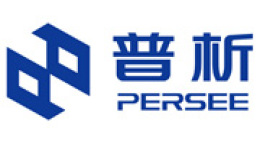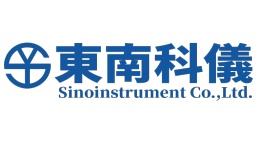水,室温离子液体,表面阳离子取向中振动和频发生光谱学研究,SFG光谱,和频光谱检测方案(其它光谱仪)
检测样品 环境水(除海水)
检测项目 振动和频发生光谱学研究,SFG光谱,和频光谱

 金牌会员
752 篇解决方案
金牌会员
752 篇解决方案
方案详情文
智能文字提取功能测试中
J. Phys. Chem. B 2003, 107, 6148-61526148 J. Phys. Chem. B, Vol. 107, No. 25, 2003 6149 10.1021/jp027753n CCC: $25.00 C2003 American Chemical SocietyPublished on Web 06/04/2003 Influence of Water on the Orientation of Cations at the Surface of a Room-TemperatureIonic Liquid: A Sum Frequency Generation Vibrational Spectroscopic Study Steven Baldelli* Department of Chemistry, University ofHouston, Houston, Texas 77204 Received: December17, 2002; In Final Form: March 25, 2003 Sum frequency generation vibrational spectroscopy was used to determine the orientation of the cations in aroom-temperature ionic liquid at the air-liquid interface. The ionic liquid that was studied was 1-butyl-3-methylimidazolium bis-trifluoromethylsulfonimide,[BMIM]+[imide]-. The orientation of the cation,[BMIM]+,was studied as a function of water pressure in the vapor over the range of 10-5 to 200 Torr. At water pressuresbelow 10-4 Torr, the imidazolium ring was oriented parallel to the surface plane. On increasing the waterpressure to greater than 10-4 Torr, the imidazolium ring tipped up from the surface with an angle along thesurface normal of 40-55°. No water signal was observed in the spectra obtained at the water pressures studiedhere. Introduction Ionic liquids are becoming a major research topic becauseof their unique physical and chemical properties. Ionic liquidsare a combination of organic cations and inorganic anions thatare liquid at room temperature. They are useful as a liquid phasein biphasic catalysis and as a medium in liquid/liquidextraction.1-3 Furthermore, their ionic nature makes themsuitable for use as conductive media in batteries, fuel cells, andsolar cells.4-6 Because many of these applications involveinterfacial chemistry, it is important to identify the structure ofthe ions at the interface to develop a molecular-level under-standing of their properties.7.8 The effect of water on theproperties of ionic liquids is also of interest because despite itslimited solubility in these liquids water greatly reduces theirutility in many applications.9,10 In the present study, we usedsurface vibrational spectroscopy to investigate the propertiesof a common room-temperature ionic liquid at the gas-liquidinterface. The insights gained in this work give a betterunderstanding of the surface chemistry of ionic liquids. The ionic liquid that was chosen for study was 1-butyl-3-methylimidazolium bis-(trifluoromethyl sulfon)imide ([BMIM]+-[imide]). The surface vibrational spectrum of this ionic liquidwas recorded using sum frequency generation (SFG) spectros-copy. We used this type of spectroscopy to probe the changesthat occur to the cation in [BMIM]+[imide]- at the gas-liquidinterface as the pressure of water in the vapor (PH2o) was variedfrom 10-5 to 102 Torr. The results suggest that at PHo<5 ×10-4 Torr the imidazolium ring is parallel to the plane of thesurface and the butyl chain is extended into the vapor phase.As the water pressure increases, the change in the SFG signalof the imidazolium ring is consistent with a reorientation ofthe ring to a tilt orientation of 40-55° from the surface normaland a twist orientation of 0-45° about the ring’s psuedo-C2axis. The maximum signal from the imidazolium ring occursat PHo ~1 Torr. The water signal was not observed at any ofthe pressures studied here. Nonlinear Spectroscopy. SFG is a nonlinear spectroscopictechnique that selectively probes molecules at an interface that has preferential polar ordering. SFG does not detect isotropicallyoriented molecules. The applications and theory behind surfaceSFG have been discussed in numerous reviews.11-16 The SFGexperiment involves overlapping two laser beams (one in theinfrared and one in the visible region) on the surface of theliquid to generate a third beam at the sum of the two incidentbeams. When the frequency of the infrared beam matches aresonance of the surface molecule, the SFG process is enhanced.A plot of sum frequency intensity versus wavenumber isinterpreted as a vibrational spectrum of the surface molecules.Varying the input polarizations and analyzing the outputpolarizations provides information on the molecular orientation.Intensity in an SFG spectrum is proportional to the square of the induced polarization, P(2): E is the electric field of the incoming visible and infrared lightfields, and x(2) is the second-order nonlinear susceptibility tensor.The measured x(2) is modified by the magnitude of the localfields at the surface, which are generally determined by use ofFresnel’s equations. The susceptibility contains all of theinformation on the molecule related to SFG spectroscopythrough the hyperpolarizability, B(2). The brackets, (), indicate an orientational average over theEuler angles, and N is the number of modes contributing to thesignal. The denominator in eq 2 describes the resonancecondition for the susceptibility, where ωq is the frequency ofthe normal mode, wn is the input infrared frequency, and I isthe damping constant for the qth vibrational mode. Thehyperpolarizability is related to the molecular properties by theproduct of the Raman polarizability, a, and the infraredtransition dipole, u, as follows: Cation Orientation at an Ionic Liquid Surface Figure 1. (A) 1-Butyl-3-methylimidazolium cation with a numberingsystem, (B) the methyl group,(C) definition of the imidazolium ring-centered and carbon-centered coordinate system (abc), (D) mutualorientation of the (abc) coordinate system with respect to the surfaceframe (xyz) with tilt angle, 0, and twist angle, d. Here, abc refers to the Cartesian coordinates centered on themolecule or functional group. To relate the quantities measuredin the laboratory reference frame to the molecular propertiesdescribed in a molecule-based coordinate system, the specificdipole and polarizability elements are transformed using rota-tional matrices. Experimental Section Optical System. The laser used in these experiments was apicosecond pulsed Nd:YAG (Ekspla) pumping an opticalparametric generator/amplifier OPG/OPA (LaserVision) togenerate infrared light tunable between 1000 and 4000 cm.The infrared beam has an energy of 300 uJ at 3000 cm- anda bandwidth of ~7 cm-1. A visible beam (532 nm) is createdby second-harmonic generation in a KTP crystal. The anglesof incidence at the surface of the infrared and visible beamswere 60 and 50°, respectively, with an energy density of ~10mJ/cm2. The SFG setup was controlled using the program LabVIEW,which scans the infrared frequency and collects the signals fromthe gated integrator. Data presented here are an average of fivescans each of 20 shots/point, continuously scanned at 1 cm-/s. All data were corrected for fluctuations in the infrared andvisible light by simultaneously collecting the SFG signalgenerated in a z-cut quartz reference sample. Spectra recordedat the same partial pressure of water are intensity normalizedto the CH3(sym) signal in the ssp spectrum (ssp = SSF, Svis, andpi are the polarizations of the optical beams). Sample Preparation. The ionic liquid 1-butyl-3-methyl-imidazolium bis-(trifluoromethylsulfon)imide was donated byProfessor Kenneth Seddon of The Queen’s University. Thesample was filtered through a 10-um frit and placed in a glasscell with Teflon/Kalrez O-rings and stopcocks. The procedure used to prepare the samples for the spectro-scopic measurements was similar to that of Brennecke et al.Briefly, prior to conducting each experiment at room temper-ature, the sample was evacuated to ~10-5 Torr on a N2(1)trapped glass vacuum line with nongreased joints and thenheated to 90°C in the cell for several hours. Water purified bya Millipore A10 water system has a resistivity of 18 M9·cmand a total organic content of less than 7 ppb (determined by aTOC meter). Water was introduced into the sample by exposingthe sample to water vapor at the desired pressure for at least 2h before the spectrum was recorded. Pressure was measuredusing an ionization gauge or a manometer, and temperature wasmonitored with a type-K thermocouple: Results The numbering scheme for the imidazolium ring is shown inFigure 1. The polarization data for [BMIM]+[imide]-at 10-Torr H2O and 1 Torr H20 are presented in Figure 2. The spectracontain six resonances (Table 1). The peaks at 2850 and 2875cm- are due to the symmetric stretch of the CH2 and CHg alkyl TABLE 1: Peak Positions and Spectroscopic Assignments" 56 assignment position (cm) 124 CH2(sym) 2850 2 CH3(sym) 2880 3 CH3(FR) 2840 4 CH3(asym) 2960,2980 5 H-C(4)C(5)-H(asym) 3120 6 H-C(4)C(5)-H(sym) 3175 1.95 0.90 0.40 0.65 “ Values indicate relative peak amplitude under the indicated SFGpolarization combination and water pressure. groups, respectively. The peaks at 2935 and 2945 cm-are theFermi resonances of the CH bending overtone and theantisymmetric CH stretch, respectively.18,19 Finally, the peaksin the aromatic ring C-H region at ~3120 and 3170 cm-l aredue to the antisymmetric and symmetric H-C(4)C(5)-Hstretches, respectively.20,21 The ppp polarization spectrum contains a peak at 2970 cm-that is assigned to the antisymmetric CH stretching vibration,along with weak features in the range of 3100-3200 cm-assigned to the C-H modes of C(4) and C(5). The sps spectrumcontains a peak at ~2980 cm-that is due to the antisymmetricCH3 stretching vibration as well as a small peak at 3170 cm-that is assigned to the symmetric H-C(4) C(5)-H stretch. The peaks observed in the spectra appear to be only fromthe aromatic ring or the butyl chain. Neither the CH(sym)stretch on the nitrogen (N3), expected at ~2930 cm-1,21,22 northe C-H stretch at the C(2) carbon that would be expected at~3000 cm-1 is observed. In addition, none of the features inthese SFG spectra is characteristic of water (3200-3750 cm-l). Discussion Orientation Analysis. A diagram of the imidazolium ion andthe ring-fixed coordinate system is given in Figure 1. Theimidazolium ring lies in the a-c plane. The orientation of thisring is defined in terms of the tilt angle (0) of the c axis withrespect to the surface normal (z axis) and a twist angle ()corresponding to the rotation of the ring about the ring-fixed caxis. A tilt of90° and a twist of 90° would bring the ring parallelto the surface plane. The orientation of the cation (methyl group and ring) isestablished on the basis of the polarization dependence ofthe SFG spectra following the procedure of Hirose et al.23-25This model assumes that the methyl group can freely rotatearound the C-C axis and that the local symmetry is C3v. TheH-C(4)C(5)-H group is treated as having local C2v sym-metry.21 To make use of the relations between orientations andx(2), the magnitudes of the tensor elements in the Ramanpolarizability and dipole vectors must be known. These weredetermined from the single-bond dipole and polarizabilities; theirvalues are presented in Table 2. The procedure for convertingthe single-bond values into normal-mode values is provided inthe references cited in Table 2. The susceptibility is a third-rank tensor with 27 elements;however, for a liquid surface, this reduces to only threeindependent elements, Xyyz, Xzzz, and Xxzx (=Xzx). The values Figure 2. SFG spectra of [BMIM]+[imide]- at the air-liquid interface. (A) ssp polarization,(B) ppp polarization, and (C) sps polarization. A-Cwere recorded at a water pressure of 5x 10-5 Torr H2O. (D) ssp polarization, (E) ppp polarization, and (F) sps polarization. D-F were recordedat 1 Torr of H2O. Lines are a fit to eq 2. Figure 3. Simulation of the influence of various tilt angles on the orientation of the CH on the butyl group in [BMIM]+. Model assumes freerotation around the C3 axis. Experimental measured results are present as horizontal lines with error bar at 1 standard deviation. TABLE 2: Bond Dipole and Polarizability Used inOrientation Analysis vibration dipole polarizability39-41 CH3 0.6 18,19,42 1.44 1.057 43 1.147 [BMIM]+, respectively. The ratio of the SFG intensities ispresented as a solid horizontal line, and the intersection of theline with the theoretical curve provides the range of values overwhich the tilt-twist angles are consistent with the data.Thisanalysis assumes a delta-function angle distribution and anisotropic x-y surface plane. are deduced by analyzing the output polarizations that resultfrom different combinations of input polarizations. For example,ssp (s-SF, s-vis, and p-IR) polarizations will probe the Xyyz tensorelement. In this paper, the ratios of various SFG intensities aresimulated as a function of tilt (0) and twist angles () for theimidazolium cation (Figure 1c). These simulated values are thencompared to the measured intensity ratios to determine the tiltand twist angles that are consistent with the experimentallydetermined SFG spectra. Figures 3 and 4 present the results ofthe simulations of the CH and H-C(4)C(5)-H groups in Neat Liquid. At pressures of less than ~10-4Torr, the onlypeaks observed in the SFG spectra are those of the methyl groupat the end of the butyl chain (Figure 2). Given that SFG issensitive only to groups at the surface, this suggests that thebutyl chains are protruding out of the surface into the vaporphase. This result is consistent with the theory that surfacecomposition is dominated by the lowest-energy component ofthe system, which in the present experiments is the alkyl chainon the imidazolium ring. In this system, the cation is likely tobe the dominant species at the surface because it is the most Figure 4. Simulation of the influence of various tilt-twist angles on the orientation of the H-C(4)C(5)-H group in [BMIM]+. Figure 5. (A) 10-5 Torr [BMIM+][PF6], (B) 10-4Torr [BMIM+][PF6-],(C) 10-5 Torr [BMIM*][imide-], and (D) 10-4 Torr [BMIM+][imide-].Pressures indicate the partial pressure of water. Lines are a fit to eq 2. polarizable species (because of charge delocalization) in theimidazolium ring. It is believed that the alkyl chain is directedinto the vapor to keep the charged imidazolium ring close tothe anion. Furthermore, the SFG results suggest that theimidazolium ring lies parallel to the surface. Given that SFGpredominantly probes vibrations with polar ordering (modes witha dynamic dipole projection along the surface normal), thetendency of the imidazolium ring to lie parallel to the surfaceplane will cause the dipole projections of the ring C-Hvibrations to be mostly aligned along the surface. Thus, C-Hring vibrations do not appear in the ssp or ppp spectrum. If theimidazolium ring is parallel to the surface normal, then theantisymmetric or symmetric modes of the H-C(4)C(5)-Hvibration or the C(2)-H vibration should be observed; however,they are not seen for the neat liquid. At water pressures greater than 5× 10-4 Torr, peakscorresponding to those of the imidazolium ring are detected(Figure 2D); specifically, the H-C(4)C(5)-H symmetric stretchat ~3175 cm- and the antisymmetric stretch at ~3130 cm-lare observed. The appearance of both the symmetric andantisymmetric modes indicates that the ring tilts to project theC(4) and C(5) carbons along the surface normal, and the appearance of the antisymmetric stretch suggests that the ringtwists about its psuedo-C2 axis. The SFG intensity is found tobe consistent with a tilt of 40-55°and twist of 0-45° at thesurface. The methyl groups on the butyl chain change their orientationat the surface when the water pressure is increased to pressuresgreater than 5 x 10-4 Torr. However, the methyl groups onthe butyl chain are less sensitive to this change,presumablybecause of the flexibility in the chain. The methyl grouporientation changes from a tilt angle of 30-45° to 35-60° withthe addition of water. Both results suggest the methyl grouphas free twist rotation about the C-C bond (Figure 3). In the bulk phase, the anions in the ionic liquid tend to becoordinated or hydrogen bonded to the aromatic protons of theimidazolium ring (i.e., in the plane of the ring).26-28 However,results have also been obtained that support the coordinationof the anion to the cationic ring (i.e., above or below the ring),an arrangement in which the association between ions isdominated by Coulombic interactions.29-32 The relative orienta-tion of the ions at the surface may differ from that in the bulkbecause the 3D symmetry of the interactions is broken at theinterface. Surface tension results for ionic liquids are consistent with ion pairs in close contact, as in concentrated H2SO4.These surface tension results, obtained by Watson’s group,support the presence of alkyl chains at the surface.34 The addition of water to an ionic liquid influences thesolvation of the ions in the liquid and consequently affects theirorientation with respect to each other. Studies of bulk ionicliquids containing water indicate only a relatively weak interac-tion between the water molecules and the ions.10 For example,infrared spectroscopic data indicates that water exists mostlyas monomers in mixtures of water with [BMIM+ and certainanions.10 In the present work, the intensity of the H-C(4)C(5)-H signal is greater for the imide than in the [PF6 ] system andis possibly related to the strength of the hydrogen bond withthe anions, where the strength is less for [PF6] than for theimide. The solubility of water in [PF6 ] and the imide issimilar.10 The weak hydrogen bonding of water with ions insolution appears to be sufficient to cause a reorientation of thecation and results in a tilting of the aromatic ring. Furthermore,hydrogen bonding between water and the C(2) hydrogen mayaccount for the ring tipping so as to point this group into thebulk liquid.27 Fluorescence studies suggest that ionic liquids aremoderately polar compounds, further supporting the weakbonding of water in the liquid.35,36 Reevacuation of the sampleto 10-5Torr caused the ring modes to disappear, indicating thatthe influence of water is completely reversible. Water featuresare not observed in the spectra, possibly because it does notadopt a polar-oriented orientation at the interface. SFG Model of the Surface in Relation to Ion-ScatteringResults. At low water concentration, the features of the SFGspectra are consistent with an interfacial structure in which thebutyl chains extend into the gas phase, away from the surface,and the imidazolium rings lie parallel to the surface. At higherwater concentrations, the rings tip along the surface normal,the butyl chains remain extended into the vapor phase, and theC(2) carbon is directed toward the bulk liquid. This structure isdifferent from that proposed by Watson’s group on the basis ofion scattering experiments.37,38 In their model, the plane of thering is parallel to the surface normal with the C(2) carbondirected toward the vapor and the alkyl chain mostly along thesurface. However, if this orientation was present, then we wouldexpect a strong signal at 3030 cm- at all pressures, and nosuch signal is observed. SFG experiments conducted using[PF6 ] as the anion also indicate that the ring is tipped alongthe surface normal at water pressures greater than 1 × 10-4Torr, as with the imide anion (Figure 5). Future experimentsusing a wider variety of anions and theoretical calculations willhelp to resolve these differences in surface orientation deter-mined by SFG and ion scattering. Conclusions SFG spectroscopy was used to determine the orientation ofthe cations at the surface of a room-temperature ionic liquid.The results suggest that at water pressures less than 10-5 Torrthe imidazolium cations are oriented such that their ring liesparallel to the surface, and at higher water concentrations, theirring is tipped along the surface normal. Acknowledgment.This project was supported by thePetroleum Research Fund (37767-G5) and start-up funds fromThe University of Houston. Eric Tyrode of KTH, Stockholm,generously provided the program in LabVIEW. References and Notes (1) Huddleston,J. G.; Willauer, H. D.; Swatloski, R. P.; Visser, A. E.;Rogers,R. D. Chem. Commun. 1998, 1765. (2) Sheldon, R. Chem. Commun. 2001, 2399. (3) Seddon, K. R. J. Chem. Technol. Biotech. 1997, 68, 351. ( ( 4) B onhote, P.; D ias, A .; P apageorgiou, N.; Kalyanasundaram, K. ; ) Gratzel, M. Inorg. Chem. 1996,35,1168. (5) Fuller, J.; Breda, A. C.; Carlin, R. T. J. Electroanal. Chem. 1998,459.29. (6) Quinn, B. M.; Ding, Z.; Moulton, R.; Bard, A. J. Langmuir 2002,18,1734. ( (7) Welton, T . Chem. Rev. 1999, 9 9,2071. ) (8) Holbrey, J. D.; Seddon, K. R. Clean Products Processes 1999, 1,223. (9) Anthony, J. L.; Maginn, E. J.; Brennecke, J. F. J.Phys. Chem. B2002,106,7315. (10) Cammarata, L.; Kazarian, S. G.; Salter, P. A.; Welton, T. Phys.Chem. Chem. Phys. 2001, 3, 5192. (11) Buck, M.; Himmelhaus, M.J. Vac. Sci. Technol., A2001,19,2717.(12) Shultz, M. J.; Baldelli, S.; Schnitzer, C.; Simonelli, D. J. Phys.Chem. B 2002, 106, 5313. (13) Bain, C. D. J. Chem. Soc., Faraday Trans. 1995, 91, 1281. (14) Huang, J. Y.; Shen, Y. R. In Sum Frequency Generation as aSurface Probe; Huang,J. Y., Shen, Y. R., Eds.; World Scientific: Singapore,1995;p5. (15) Miranda, P. B.; Shen, Y. R. J. Phys.Chem. B 1999, 103, 3292. (16) Shultz, M. J.; Schnitzer, C.; Simonelli, D.; Baldelli, S. Int. Rev.Phys. Chem. 2000, 19, 123. (17) Anthony,J. L.; Maginn, E. J.; Brennecke, J. F. J. Phys. Chem. B2001,105,10942. (18) Snyder, R. G. J. Chem. Phys. 1965, 42, 1744. (19) Snyder, R. G.; Strauss, H. L.; Elliger, C. A. J. Phys. Chem. 1982,86,5145. (20) Sadlej,J.; Jaworski, A.; Miaskiewicz, K. J.Mol. Struct. 1992, 274,247. ( (21) C arter, D. A.; Pemberton, J . E. J . Raman Spectrosc . 1997,28,939. ) (22) Carter, D. A.; Pemberton, J. E.; Woelfel, K.J. J. Phys. Chem. B1998,102,9870. (23) Akamatsu, N.; Domen, K.; Hirose, C. Appl. Spectrosc. 1992, 46,1051. (24) Akamatsu, N.; Domen, K.; Hirose, C.; Yamamoto, H. J. Phys.Chem. 1993, 97,10064. (25) Hirose, C.; Akamatsu, N.; Domen, K. J. Chem. Phys. 1992, 96,997. (26) Wilkes, J. S.; Zaworotko, M. J. J. Chem. Soc., Chem. Commun.1992, 965. (27) Elaiwi, A.; Hitchcock, P.; Seddon, K.; Srinivasan, N.; Tan, Y.;Welton, T.; Zora, J. J. Chem. Soc., Dalton Trans. 1995,3467. (28) Abdul-sada, A. K.; Greenway, A. M.; Hitchcock, P. B.; Mohammed,T. J.; Seddon, K. R.; Zora, J. A. J. Chem. Soc., Chem. Commun. 1986,1753. (29) Dieter, K. M.; Dymek, C. J.; Heimer, N. E.; Rovang,J. W.; Wilkes,J. S. J. Am. Chem. Soc.1988,110,2722. (30) Andrade, J.; Boes,E. S.; Stassen, H. J. Phys. Chem. B 2002, 106,13344. (31) Fuller, J.; Carlin, R. T.; De Long, H. C.; Haworth, D. J. Chem.Soc., Chem. Commun. 1994, 299. (32) Gordon, C. M.; Holbrey, J.D.; Kennedy, A. R.; Seddon, K. R. J.Mater. Chem. 1998, 8,2627. (33) Phillips, L. F. Aust.J. Chem. 1994, 47, 91. (34) Law, G.; Watson, P. R. Langmuir 2001, 17,6138. (35) Karmakar, R.; Samanta, A. J. Phys. Chem. A 2002, 106,4447. (36) Aki, S. N.V. K.; Brennecke, J. F.; Samanta, A. Chem. Commun.2001,5,413. (37) Gannon, T. J.; Law, G.; Watson, P. R.; Carmichael, A. J.; Seddon,K. R. Langmuir 1999, 15, 8429. (38) Law, G.; Watson, P. R.; Carmichael, A. J.; Seddon, K. R. Phys.Chem. Chem. Phys.2001.3.2879. (39) Gough, K. M.; Srivastava, H. K.; Belohorcova, K. J. Chem. Phys.1993, 98,669. (40) Gough, K. M.; Murphy, W. F.; Stroyer, T.; Svendsen, E. N. J.Chem. Phys. 1987,87,3341. (41) Gough, K. M. J. Chem. Phys. 1989, 91,2424. (42) MacPhail, R. A.; Strauss, H. L.; Snyder, R. G.; Elliger, C. A. J.Phys. Chem. 1984, 88, 334. (43) Pulay, P.; Fogarasi, G.; Boggs, J. E. J. Chem. Phys. 1981,74,3999.
关闭-
1/5
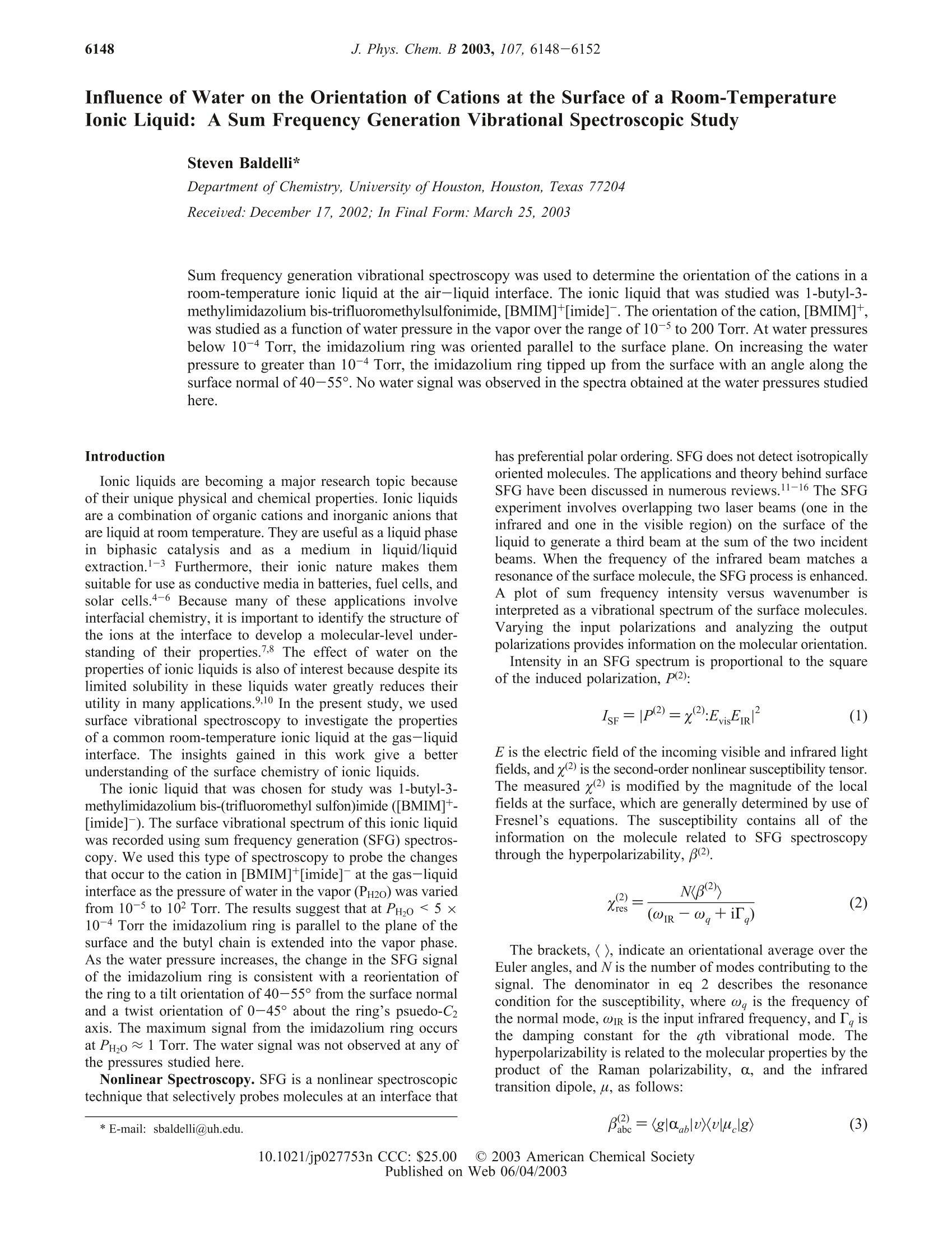
-
2/5
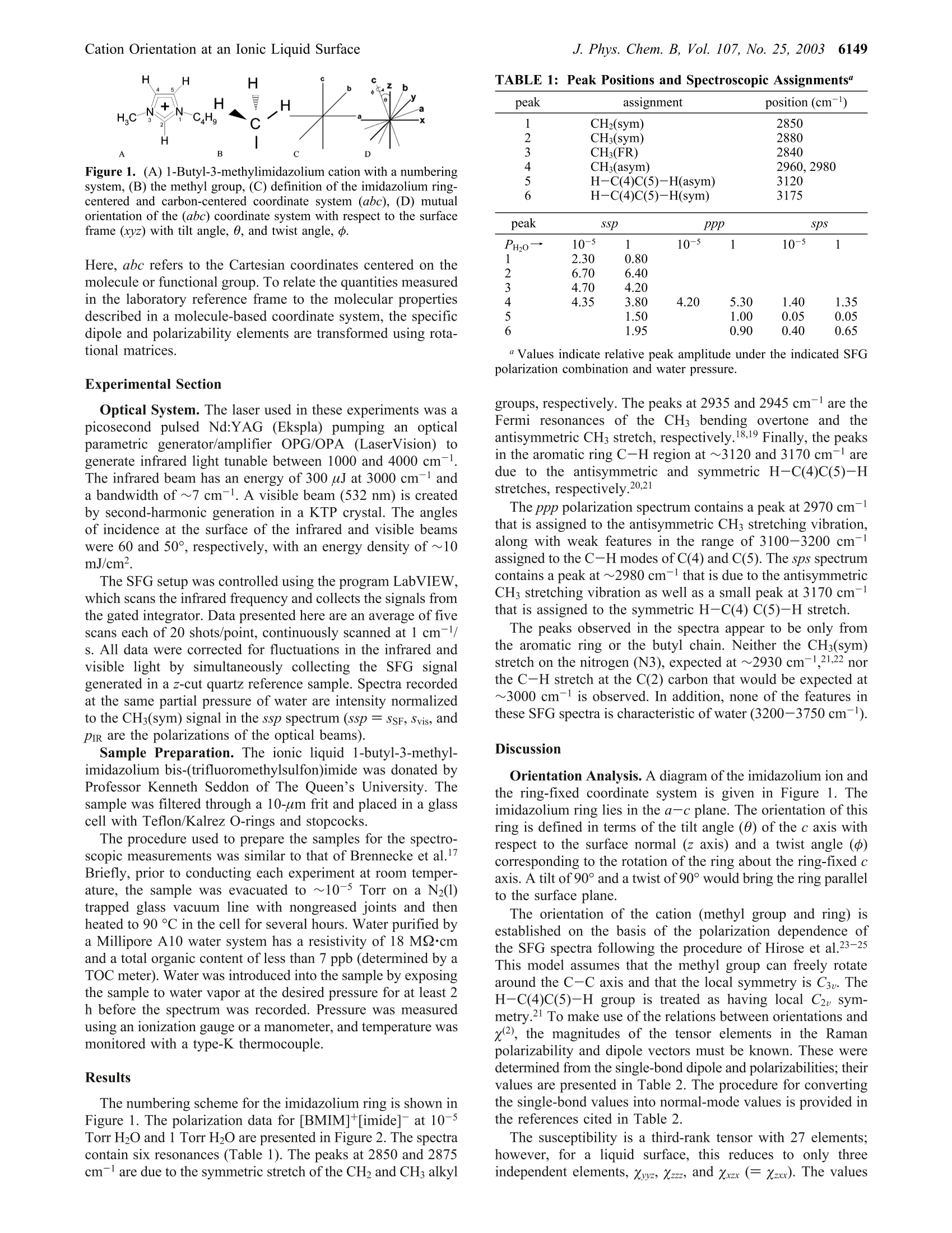
还剩3页未读,是否继续阅读?
继续免费阅读全文产品配置单
北京欧兰科技发展有限公司为您提供《水,室温离子液体,表面阳离子取向中振动和频发生光谱学研究,SFG光谱,和频光谱检测方案(其它光谱仪)》,该方案主要用于环境水(除海水)中振动和频发生光谱学研究,SFG光谱,和频光谱检测,参考标准《暂无》,《水,室温离子液体,表面阳离子取向中振动和频发生光谱学研究,SFG光谱,和频光谱检测方案(其它光谱仪)》用到的仪器有Ekspla SFG 表面和频光谱分析系统、PL3140 皮秒Nd:YLF激光器、Ekspla CARS 相干反斯托克斯拉曼显微光谱仪。
我要纠错
推荐专场
相关方案
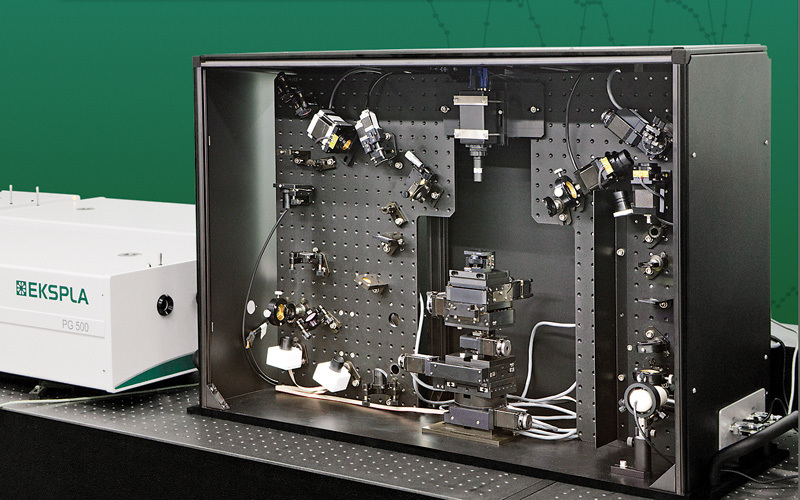
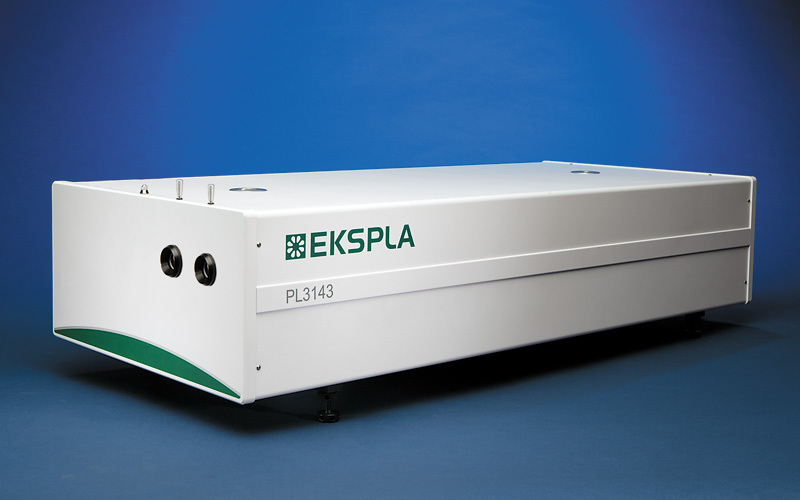
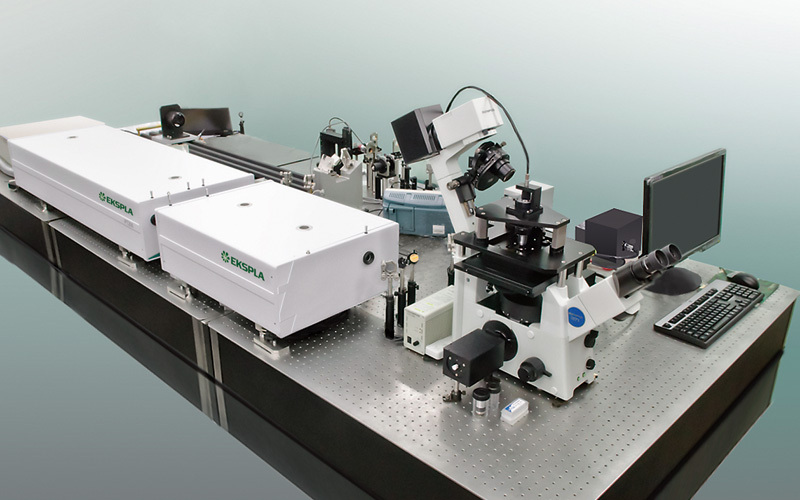


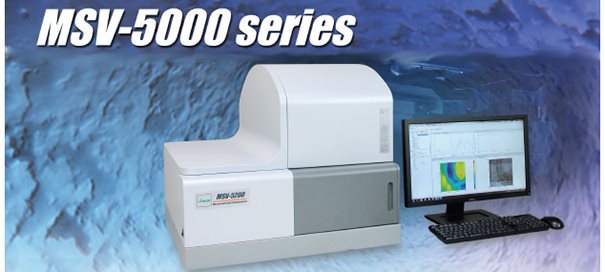



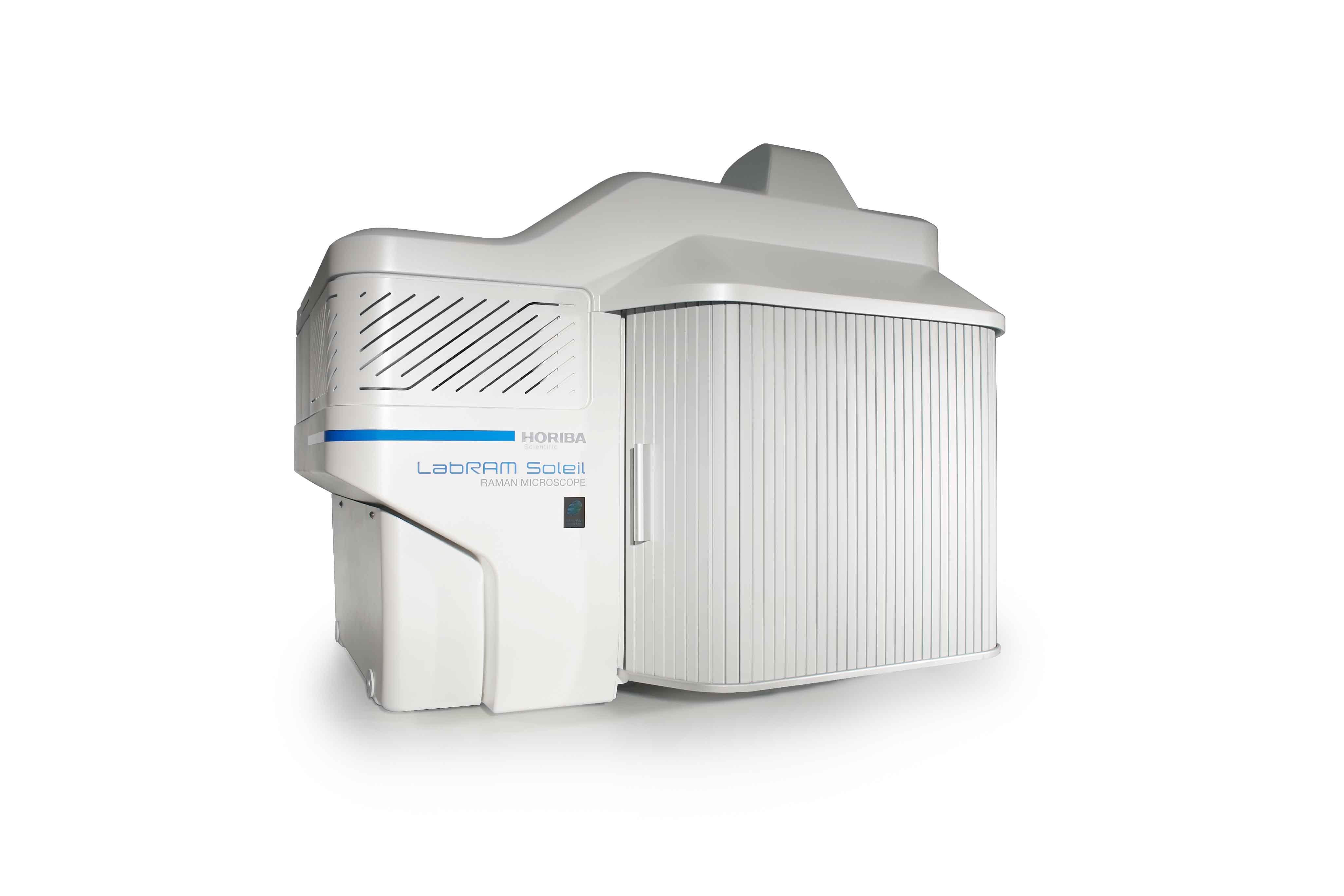

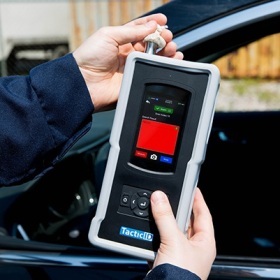
 咨询
咨询



